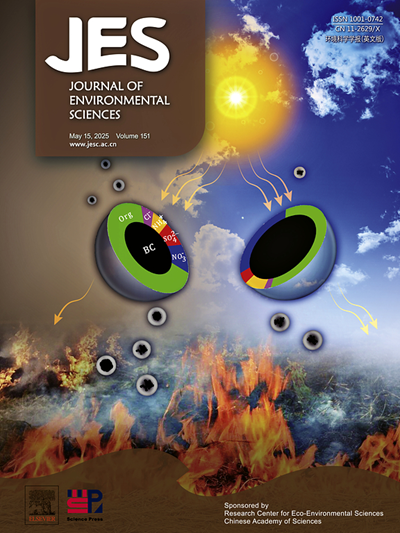A green process for total nitrogen removal without extra energy consumption: Synergistic actions for wastewater treatment
IF 5.9
2区 环境科学与生态学
Q1 ENVIRONMENTAL SCIENCES
引用次数: 0
Abstract
Total nitrogen (TN) removal is one of the key issues in improving water quality, while the traditional nitrification-denitrification process with its high energy consumption is unsustainable, due to greenhouse gas (GHG) emission. A method using organic-inorganic pellets and selected microalgae that can operate without electricity consumption was designed for TN removal in actual wastewater treatment. The results showed that the TN removal efficiencies with different pellets were 88.2 % ± 2.2 %, 86.6 % ± 3.0 %, 85.4 % ± 4.3 %, and 82.3 % ± 6.5 %, respectively. Microalgae assimilated inorganic nitrogen within cells, resulting in a significant positive relationship with TN (P < 0.05), and effectively removed TN through sedimentation. The pellets adsorbed nitrogen and microorganisms, released organic substances to regulate the ratio of water chemical oxygen demand (COD) to TN, and correspondingly influenced microbial growth. Microalgae and bacteria such as Romboutsia, Proteiniclasticum, and Rhodopseudomonas cooperated to form a mixed aerobic (water) -anaerobic (pellets) environment in the devices, and acted synergistically to remove TN. This study verifies the feasibility of TN removal with only solar energy in a low flow application in large spaces, benefiting carbon neutrality in wastewater treatment.

无额外能源消耗的全氮去除绿色工艺:废水处理的协同作用
总氮(TN)的去除是改善水质的关键问题之一,而传统的硝化-反硝化工艺由于温室气体(GHG)的排放,其高能耗是不可持续的。在实际废水处理中,设计了一种采用有机-无机颗粒和可无电运行的微藻去除TN的方法。结果表明,不同颗粒对TN的去除率分别为88.2%±2.2%、86.6%±3.0%、85.4%±4.3%和82.3%±6.5%。微藻吸收细胞内无机氮,与TN (P <)呈显著正相关;0.05),通过沉淀有效去除TN。颗粒吸附氮和微生物,释放有机物调节水体化学需氧量(COD / TN)的比例,从而影响微生物的生长。微藻与Romboutsia、Proteiniclasticum、Rhodopseudomonas等细菌在装置内共同形成好氧(水)-厌氧(球)混合环境,协同去除TN。本研究验证了在大空间低流量应用中仅利用太阳能去除TN的可行性,有利于废水处理中的碳中和。
本文章由计算机程序翻译,如有差异,请以英文原文为准。
求助全文
约1分钟内获得全文
求助全文
来源期刊

Journal of Environmental Sciences-china
环境科学-环境科学
CiteScore
13.70
自引率
0.00%
发文量
6354
审稿时长
2.6 months
期刊介绍:
The Journal of Environmental Sciences is an international journal started in 1989. The journal is devoted to publish original, peer-reviewed research papers on main aspects of environmental sciences, such as environmental chemistry, environmental biology, ecology, geosciences and environmental physics. Appropriate subjects include basic and applied research on atmospheric, terrestrial and aquatic environments, pollution control and abatement technology, conservation of natural resources, environmental health and toxicology. Announcements of international environmental science meetings and other recent information are also included.
 求助内容:
求助内容: 应助结果提醒方式:
应助结果提醒方式:


